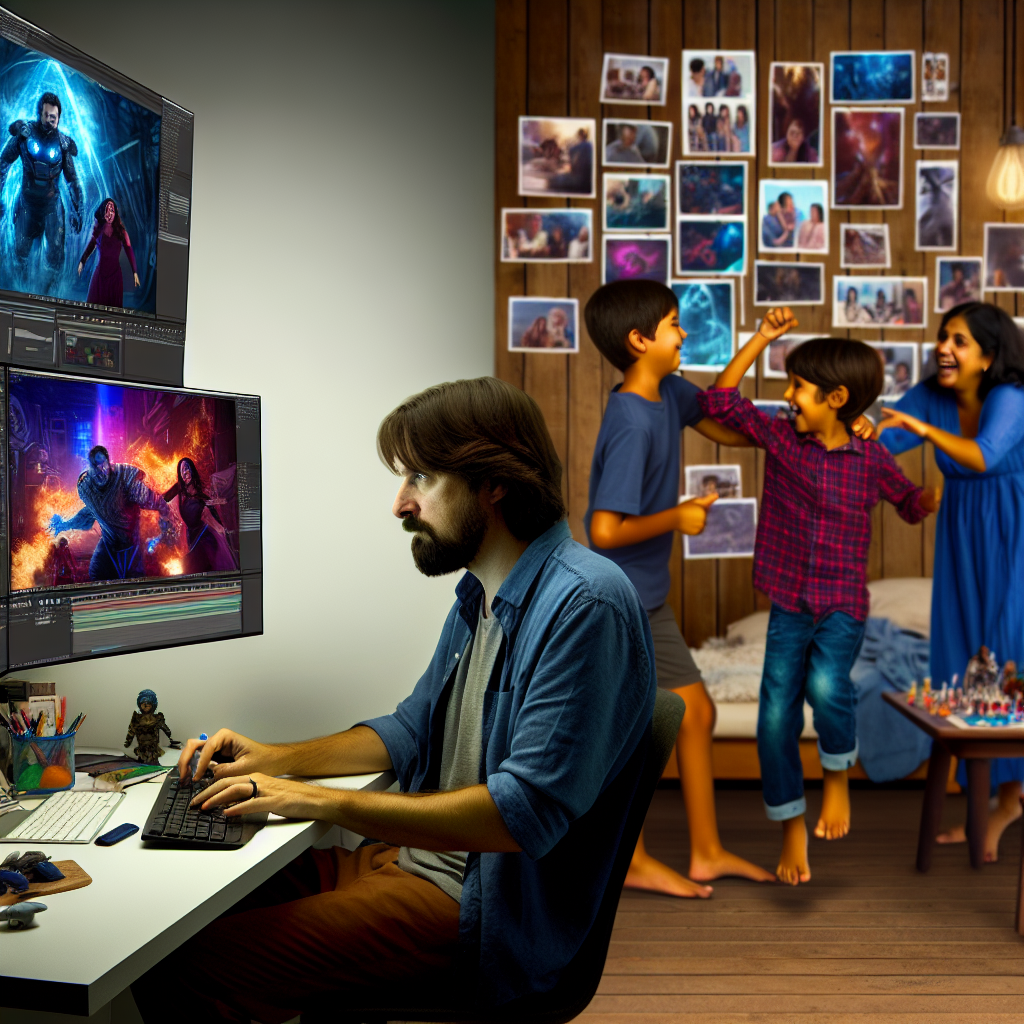Introduction
VFX artists create stunning visual effects for film, television, and video games.
They blend imagination with technical skills to produce eye-catching images.
Their work ranges from realistic simulations to fantastical creatures.
VFX artists play a crucial role in storytelling, bringing narratives to life.
However, the VFX industry is known for its demanding nature.
Long hours and tight deadlines often characterize studio life.
The pressure to meet client expectations can lead to burnout.
Thus, establishing a work-life balance is essential for VFX artists.
Importance of Work-Life Balance
Work-life balance protects mental and physical health.
VFX artists who maintain balance perform better and produce higher-quality work.
They experience less stress and greater creativity, enhancing their job satisfaction.
When VFX artists do not prioritize balance, they risk burnout.
Fatigue can lead to errors, affecting project quality and timelines.
This cycle can create a negative work environment, impacting team morale.
Fostering a healthy balance also boosts job security.
Companies value employees who manage their time effectively.
When artists demonstrate resilience, they often become indispensable team members.
Moreover, a balanced lifestyle promotes personal growth.
Artists who set boundaries have more time to explore interests outside of work.
Engaging in hobbies can inspire creativity and fuel professional work.
Transform Your Career Today
Unlock a personalized career strategy that drives real results. Get tailored advice and a roadmap designed just for you.
Start NowTips for Achieving Balance
To achieve a healthy work-life balance, VFX artists should start by setting boundaries.
Establish a dedicated workspace and limit work hours to maintain focus.
Make time for breaks during work hours to recharge and refresh.
Prioritize tasks using organizational tools like to-do lists or project management software.
Breaking projects into manageable chunks reduces overwhelm and enhances productivity.
Additionally, communicate openly with peers and supervisors.
Share concerns about deadlines and workload.
Seek support when necessary and collaborate with others for solutions.
Lastly, engage in regular self-care practices.
Exercise, meditation, and leisure activities can significantly reduce stress levels.
By prioritizing personal well-being, VFX artists can thrive creatively and professionally.
Importance of Work-Life Balance for VFX Artists
VFX artists play a crucial role in creating stunning visuals in films, games, and commercials.
Their work often involves high-pressure deadlines and incredibly long hours.
A healthy work-life balance is vital for their success and well-being.
Artists must manage their time and energy efficiently to maintain quality in their work and avoid burnout.
High-Pressure Deadlines and Long Work Hours
VFX production often operates on tight schedules.
Clients expect rapid turnarounds for high-quality content.
Many projects require artists to work long hours to meet these demands.
This situation can lead to stress and affect personal lives significantly.
It is essential to recognize the following points:
Transform Your Career Today
Unlock a personalized career strategy that drives real results. Get tailored advice and a roadmap designed just for you.
Start Now- Project Deadlines: Artists frequently deal with looming deadlines, increasing pressure to deliver quality work quickly.
- Overtime Work: Many VFX artists work overtime, sacrificing personal time for project completion.
- Team Collaboration: Collaborative efforts can amplify stress, especially when group members have varying work styles.
- Client Expectations: Artists often navigate client feedback, which can change at any moment, causing additional strain.
- Cinematic Trends: Rapid technological changes demand that artists continuously adapt and learn.
While passion for the craft often drives VFX artists, the pressure can be overwhelming.
Balancing work commitments with personal life becomes essential for long-term success.
Without proper balance, the excitement for the craft can diminish, ultimately affecting creativity.
Mental and Physical Health Implications of Overwork
Chronic overwork poses serious risks to mental and physical health.
VFX artists often overlook self-care in favor of project deadlines.
This neglect can lead to severe implications, including:
- Burnout: Long hours can lead to emotional exhaustion and decreased job satisfaction.
- Sleep Deprivation: Late-night work sessions often disrupt normal sleep patterns, affecting overall health.
- Anxiety and Depression: Persistent stress can contribute to feelings of anxiety and depression.
- Poor Physical Health: Sedentary work often leads to weight gain, back pain, and other health issues.
- Substance Abuse: Some may resort to unhealthy coping mechanisms to deal with stress.
These health implications extend beyond the workplace.
They affect relationships, creativity, and even career longevity.
Therefore, prioritizing work-life balance can enhance overall well-being.
Finding Balance: Strategies for VFX Artists
Achieving a healthy work-life balance is essential for VFX artists.
Here are some effective strategies to implement:
- Set Clear Boundaries: Everyone needs boundaries. Define work hours and stick to them. Communicate these hours to colleagues and clients.
- Prioritize Tasks: Organize work by priority. Use project management tools to track progress and deadlines, allowing for more efficient workflow.
- Schedule Breaks: Regularly scheduled breaks can boost productivity. Short breaks can refresh the mind and improve focus.
- Utilize Time Management Techniques: Techniques like the Pomodoro Technique can help manage time effectively, breaking work into manageable intervals.
- Embrace Flexibility: If possible, negotiate flexible work hours. Flexibility can reduce stress and enhance creativity.
- Delegate Responsibilities: Teamwork is vital. Share responsibilities with team members to create a balanced workload.
Implementing these strategies requires discipline and practice.
However, VFX artists who actively work on these areas will likely find increased fulfillment in both personal and professional lives.
Investing in Mental and Physical Well-being
Maintaining good mental and physical health is critical in the demanding world of VFX.
Artists must invest time into self-care.
Here are proactive steps to consider:
- Exercise Regularly: Physical activity improves mood and energy levels. Commit to regular workouts to combat the sedentary nature of the work.
- Practice Mindfulness: Mindfulness techniques can reduce stress. Meditation, yoga, and deep-breathing exercises help maintain emotional balance.
- Seek Professional Help: If needed, consult a mental health professional. They can provide effective coping strategies and support.
- Engage in Hobbies: Pursue interests outside of work to recharge. Hobbies improve creativity and serve as a healthy distraction.
- Build a Support Network: Connect with peers who understand the struggles of the industry. Sharing experiences can provide relief and foster community.
Investing in mental and physical well-being enhances overall productivity.
Artists who prioritize their health often produce higher-quality work.
They also enjoy greater job satisfaction and creativity.
Strategies for Sustaining Success and Happiness
Achieving a healthy work-life balance is vital for VFX artists.
Transform Your Career Today
Unlock a personalized career strategy that drives real results. Get tailored advice and a roadmap designed just for you.
Start NowHigh-pressure deadlines and long hours can overwhelm even the most passionate creatives.
Recognizing the importance of balance helps prevent burnout and promotes well-being.
By implementing strategic practices and prioritizing mental and physical health, VFX artists can navigate their careers sustainably.
This balance leads to both professional success and personal happiness.
Maintaining a Healthy Work-Life Balance as a VFX Artist
Maintaining a healthy work-life balance is crucial for VFX artists.
The demanding nature of this profession can often blur the lines between personal time and work.
Therefore, setting boundaries becomes essential.
Here are some actionable tips for establishing those critical boundaries.
Establishing Clear Work Hours
First and foremost, decide on your work hours.
Sticking to a clear schedule is foundational for maintaining balance.
- Select Your Hours: Choose a routine that fits your lifestyle. Ensure it accommodates your peak productivity times.
- Communicate Your Schedule: Inform your team about your start and end times. This creates an expectation for when you are available.
- Use Tools: Utilize calendars or scheduling apps to block off your work hours. Set reminders for breaks and end times.
- Avoid Overtime: Make it a rule to complete your work during the designated hours. Avoid extending your workday unnecessarily.
- Evaluate Weekly: At the end of each week, assess your adherence to your schedule. Make adjustments if necessary.
By establishing and sticking to clear work hours, you make a strong statement about your boundaries.
This protects your personal time and boosts overall productivity.
Communicating with Supervisors and Team Members
Effective communication plays a significant role in maintaining boundaries.
When you talk openly about your workload and boundaries, you set realistic expectations.
- Discuss Workload Regularly: Have frequent check-ins with your supervisors. This dialogue helps manage expectations on projects and deadlines.
- Be Honest: If you feel overwhelmed, express your concerns promptly. Transparency cultivates a supportive work environment.
- Set Up Boundaries for Communication: Define when you will and won’t check emails or respond to messages. Communicate this with your team.
- Use “Do Not Disturb” Features: Use software settings that allow you to work without interruptions. Protect your focus during work hours.
- Advocate for Resource Support: If tasks pile up, don’t hesitate to ask for additional resources or assistance. This can alleviate your workload.
When you communicate your boundaries effectively, it encourages others to respect them too.
This creates a more balanced and harmonious work environment.
Balancing Project Deadlines and Personal Time
One of the greatest challenges as a VFX artist is managing multiple projects simultaneously.
Balancing tight deadlines while maintaining personal time requires strategy.
- Prioritize Tasks: Each day, list out and rank tasks by urgency and importance. Focus on high-priority items without neglecting smaller tasks.
- Set Interim Deadlines: Break larger projects into manageable sections. Reward yourself for completing each section to maintain motivation.
- Build Buffer Time: Always include buffer time in your project plans. This helps accommodate unexpected issues without sacrificing personal time.
- Assess Workload Realistically: When taking on new projects, assess your current workload honestly. Don’t stretch yourself too thin.
- Maintain a Flexible Mindset: Sometimes, adaptations are necessary. Stay open to adjusting your schedule if urgent issues arise.
By balancing deadlines and personal time, you prevent burnout.
This also enhances your creativity and effectiveness in VFX work.
Transform Your Career Today
Unlock a personalized career strategy that drives real results. Get tailored advice and a roadmap designed just for you.
Start NowEncouraging a Supportive Work Culture
Fostering a culture that respects work-life boundaries benefits everyone.
Their support can make a significant difference in your daily routine.
- Lead by Example: Demonstrate the importance of work-life balance in your actions. Show that boundaries matter.
- Share Success Stories: Discuss instances where maintaining boundaries led to productivity boosts. These stories can inspire peers.
- Promote Mental Health Resources: Advocate for mental health days or workshops within your studio. Healthy discussions generate supportive environments.
- Organize Team Activities: Suggest after-work activities that foster camaraderie. This strengthens relationships without infringing on personal time.
- Recognize Individual Contributions: Take time to appreciate your coworkers’ efforts. Appreciation embraces a culture of respect and acknowledgment.
Encouraging a supportive work culture significantly enhances everyone’s experience.
This collective effort promotes well-being and productivity.
Utilizing Technology Wisely
Technology serves as both a blessing and a curse in maintaining boundaries.
You can leverage it effectively to create a healthy work-life balance.
- Automate Repetitive Tasks: Use automation tools for sifting through emails and organizing tasks. This frees up your time for creative work.
- Set Notifications Wisely: Manage notification settings on professional platforms. Limit distractions during your focused hours.
- Utilize Project Management Tools: Implement software designed for task organization. This keeps your workload organized without traditional methods.
- Engage in Virtual Hangouts: Use video conferencing for team connections. Foster relationships without needing to meet in person.
- Practice Digital Detox: Designate tech-free hours during your personal time. This rejuvenates your mind away from screens.
By using technology wisely, you can enhance productivity while creating time for yourself.
Balance is about making the right choices with the tools at hand.
The path to a harmonious work-life balance as a VFX artist requires conscious effort and thoughtful strategies.
Establishing clear work hours, communicating effectively, balancing deadlines, fostering a supportive work culture, and leveraging technology are all crucial steps in this journey.
As you implement these tips, remember that prioritizing your personal life benefits you and enriches your work.
With diligence and commitment, achieving a healthy balance is entirely possible.
Uncover the Details: Essential Networking Tips for Influencer Relations Pros
Strategies for Managing Stress
The life of a VFX artist can be exhilarating yet demanding.
Long hours, tight deadlines, and the need for precision create a unique stress environment.
To maintain a healthy work-life balance, artists must actively manage their stress levels.
Here are effective strategies to incorporate into your daily routine.
Incorporating Relaxation Techniques into Daily Routine
Relaxation techniques can significantly reduce stress.
By integrating them into your daily routine, you create a buffer against work-related pressures.
Here are some methods to consider:
Transform Your Career Today
Unlock a personalized career strategy that drives real results. Get tailored advice and a roadmap designed just for you.
Start Now-
Mindfulness Meditation: Spend ten minutes daily focusing on your breath.
-
Progressive Muscle Relaxation: In the evening, practice tensing and relaxing each muscle group.
-
Deep Breathing Exercises: Take deep, slow breaths during stressful moments.
-
Yoga: Incorporate yoga into your routine to enhance flexibility and reduce stress.
-
Regular Breaks: During work sessions, step away from your screen every hour.
-
Nature Walks: Spend time outdoors.
-
Creative Outlets: Engage in hobbies outside of work, such as painting or music.
Seeking Support from Friends, Family, or Therapists
Building a robust support network is crucial.
Communicating with loved ones about your experiences can lighten your emotional load.
Here are some ways to seek and benefit from support:
-
Open Communication: Talk to friends and family about your feelings.
-
Join Community Groups: Participate in local or online VFX forums.
-
Schedule Quality Time: Prioritize time with loved ones.
-
Professional Help: Consider talking to a therapist.
-
Set Boundaries: Clearly communicate your work needs to friends and family.
-
Accountability Partner: Find a mentor or friend who understands your career.
-
Engage in Group Activities: Participate in social events or group projects.
As VFX artists navigate the intricacies of their profession, they must prioritize their well-being.
Implementing effective relaxation techniques and building a supportive network can greatly enhance their ability to manage stress.
Remember, you are not alone in this journey.
By taking proactive steps, you can carve out a fulfilling space in both your work and personal life.
Embracing these strategies not only supports your mental health but also enriches your creative output.
A balanced life ultimately leads to greater productivity and satisfaction in your work as a VFX artist.
When you manage stress effectively, you’ll find yourself enjoying the craft and contributing meaningful work to the industry.
Find Out More: How to Attract High-End Event Planning Clients
Balancing Personal Life with Work
Finding balance between personal life and work is crucial for VFX artists.
The demands of the industry can be intense.
Long hours and tight deadlines often tempt artists to neglect their personal lives.
However, prioritizing personal time can improve creativity and work quality.
Below are several tips to achieve a healthy balance.
Making Time for Hobbies and Interests Outside of VFX Work
Engaging in hobbies outside of work can rejuvenate your mind and spirit.
Here are some strategies to make time for these important activities:
- Schedule Your Hobbies: Treat your hobbies like appointments. Block out time in your calendar for them.
- Set Realistic Goals: Start small. Dedicate a few hours each week to a hobby you enjoy.
- Explore New Interests: Don’t hesitate to try new activities. Join a dance class or learn to play an instrument.
- Involve Friends: Engage friends or family in your hobbies. This can add social interaction to personal time.
- Limit Screen Time: Reducing time on social media can open space for other interests. Use this time for personal growth.
- Find Inspiration: Attend workshops or events related to your interests. This can encourage you to pursue them more actively.
- Use Your Weekend: Reserve weekends for personal activities. Make them fun and relaxing to recharge for the week ahead.
Prioritizing Self-Care and Downtime
Self-care plays a vital role in maintaining work-life balance.
Regular downtime helps reduce stress and prevents burnout.
Transform Your Career Today
Unlock a personalized career strategy that drives real results. Get tailored advice and a roadmap designed just for you.
Start NowConsider these self-care strategies:
- Create a Relaxation Routine: Establish a daily routine that includes relaxation practices. Meditation, deep breathing, or yoga can be effective.
- Get Enough Sleep: Ensure you prioritize quality sleep. Aim for 7-9 hours each night to promote mental clarity.
- Stay Active: Regular physical activity boosts mood and energy levels. Even a daily walk can make a significant difference.
- Practice Mindfulness: Take mindfulness breaks throughout the day. Short meditative periods can enhance focus and relieve tension.
- Set Boundaries: Define your work hours and stick to them. Communicate these boundaries clearly with your colleagues.
- Unplug Regularly: Take breaks from technology. Allow yourself time away from screens to recharge your mental capacity.
- Indulge in Leisure Activities: Watch movies, read books, or explore nature. Engage in activities that bring you joy and relaxation.
Maintaining balance can be challenging, especially in a fast-paced industry.
However, prioritizing personal time and self-care leads to long-term benefits.
Finding this balance directly impacts creativity, productivity, and overall satisfaction in both work and life.
Regularly evaluate your schedule and interests to adjust as needed.
Remember that personal fulfillment supports professional success.
Taking care of yourself enables your best work as a VFX artist.
Cultivating a well-rounded life enriches your artistry and enhances your passion for VFX.
Find Out More: Building a Successful Career as a Camera Operator
Importance of Physical Health
Maintaining physical health is crucial for VFX artists.
Sedentary jobs often lead to various health issues.
Balancing creative work with physical activity enhances overall well-being.
Following specific tips can help you stay active and healthy, even when working long hours at a desk.
Tips for Staying Active and Healthy While Working in a Sedentary Job
Incorporating movement into your daily routine is essential.
Here are some actionable tips to stay active:
- Set a Timer: Use a timer to remind you to move every hour. Even a five-minute walk can do wonders.
- Desk Exercises: Perform simple desk exercises to stretch your muscles. Examples include shoulder rolls and wrist stretches.
- Invest in a Standing Desk: Consider using a standing desk or a desk converter. This change can reduce the amount of time spent sitting.
- Walk During Breaks: Use your breaks to take brisk walks. Aim for at least 10-15 minutes of walking during each break.
- Lunch Break Workouts: Consider doing quick workouts during your lunch break. A short, high-intensity workout can energize you for the rest of the day.
- Participate in Group Activities: Join group activities or classes with colleagues. Engaging in physical activity together can increase motivation.
- Incorporate Movement into Your Commute: If possible, walk or bike to work. If you use public transport, consider getting off early to walk the rest of the way.
- Stay Hydrated: Drinking enough water promotes better health. Keep a water bottle at your desk to remind you to drink throughout the day.
Importance of Regular Breaks and Movement During Work Hours
Taking regular breaks helps prevent burnout and enhances productivity.
Here’s why breaks are vital:
- Mental Clarity: Short breaks can improve focus. Stepping away from your work allows your mind to recharge.
- Improved Creativity: A change of scenery can inspire new ideas. Taking a walk, for instance, can spark your creativity.
- Reduced Physical Strain: Continuous sitting can lead to strain. Regular movement alleviates tension in muscles and joints.
- Enhanced Mood: Breaks help reduce stress levels. Engaging in light activities boosts endorphin levels, enhancing overall mood.
- Increased Productivity: Taking breaks often results in better productivity. Working in short sprints allows for more effective output.
To maximize the benefits of breaks, consider the following strategies:
- Schedule Breaks: Plan specific times for breaks. Treat them like appointments to ensure you prioritize them.
- Change Your Environment: Step outside or move to a different room for breaks. This change revitalizes your mind and body.
- Incorporate Breathing Exercises: Use breaks to practice deep breathing. This simple technique can reduce stress levels significantly.
- Use Breaks for Quick Workouts: Perform short workout routines. Jumping jacks or squats can invigorate you between tasks.
- Engage in Mindfulness: Consider practicing mindfulness or meditation during breaks. This practice promotes relaxation and reduces anxiety.
Remember, your physical health directly influences your creative output.
Prioritizing these strategies creates a healthier work-life balance.
Transform Your Career Today
Unlock a personalized career strategy that drives real results. Get tailored advice and a roadmap designed just for you.
Start NowAs a VFX artist, staying active and healthy is not just essential; it’s a pathway to sustained creativity and joy in your work.
See Related Content: How to Develop a Corporate Communications Strategy

Creating a Supportive Work Environment
A supportive work environment significantly enhances the work-life balance of VFX artists.
It fosters creativity, productivity, and overall well-being.
To build such an environment, consider the following strategies:
Seeking Out Companies With Positive Workplace Cultures
-
Research Company Values: Before applying, investigate the company’s values. Look for alignment with your own. Positive cultures often prioritize fairness, respect, and collaboration.
-
Explore Company Reviews: Websites like Glassdoor provide insights into employee experiences. Reading reviews can illuminate company strengths and weaknesses.
-
Look for Employee Benefits: Companies that value work-life balance offer generous benefits. Examples include flexible hours, remote work options, and mental health support.
-
Examine Diversity and Inclusion Efforts: Companies committed to diversity foster an inclusive environment. An inclusive workplace encourages creativity and innovation among employees.
-
Consider Career Growth Opportunities: A supportive company invests in employee development. Look for training programs, mentorship, and advancement opportunities.
-
Assess Management Style: Strong leaders contribute to a positive culture. Observe how management interacts with staff. Open communication fosters trust and respect.
Building Relationships With Colleagues and Supervisors for Support
Establishing strong relationships with colleagues and supervisors is crucial for a supportive environment.
These relationships can provide emotional and professional support.
-
Engage in Team Building Activities: Participate in team events and bonding activities. These activities help break down barriers and build strong connections.
-
Communicate Regularly: Open lines of communication enhance collaboration. Regular check-ins not only improve project flow but also foster friendships.
-
Offer Help: Be proactive in offering help to your colleagues. Providing support can create a collaborative atmosphere conducive to teamwork.
-
Seek Feedback: Engaging supervisors for feedback can improve your performance. This approach also demonstrates your willingness to grow and learn.
-
Celebrate Successes Together: Recognizing team achievements fosters camaraderie. Celebrations motivate everyone and build collective pride.
-
Participate in Professional Networks: Joining industry-related groups enables you to meet others. Networking can lead to professional connections and mentorship opportunities.
Encouraging a Positive Work-Life Balance
Supporting a healthy work-life balance encompasses more than individual efforts.
Encouraging this balance among colleagues fosters an overall healthier work environment.
-
Promote Time Management: Encourage the use of tools for effective time management. Efficient scheduling enhances productivity and allows for better life integration.
-
Set Boundaries: Establish clear boundaries between work and personal time. For example, avoid working late hours or during off-days whenever possible.
-
Encourage Taking Breaks: Promote regular breaks throughout workdays. Short breaks improve focus and reduce burnout risks.
-
Share Workload: Be open to sharing tasks, especially during busy periods. Delegating responsibilities can prevent overwhelming anyone and improve morale.
-
Encourage Healthy Habits: Support initiatives that promote physical health. Encourage participation in exercise classes or wellness programs.
-
Organize After-Work Activities: Plan socializing events outside the office. These gatherings can strengthen relationships and foster a sense of community.
Creating an Open Environment for Feedback
A culture of open feedback nurtures growth and improvement.
It allows team members to express their needs regarding work-life balance.
-
Implement Regular Feedback Mechanisms: Use surveys and one-on-one meetings to gather input. Regular feedback allows employees to express their thoughts comfortably.
-
Foster an Atmosphere of Trust: Build trust by responding to feedback constructively. Encourage an environment where everyone feels safe sharing their opinions.
-
Encourage Mentorship Programs: Pairing experienced members with newer team members nurtures personal development. Mentorship can fortify relationships and provide guidance.
-
Address Concerns Promptly: Acknowledge and address any issues raised. Responding promptly can prevent frustration and reinforce confidence in management.
-
Provide Professional Development Opportunities: Encourage team members to seek training and workshops. Continuous learning strengthens expertise and provides personal satisfaction.
-
Celebrate Milestones: Recognize individual and team milestones together. Celebrating achievements boosts morale and reinforces teamwork.
Strategies for Enhancing Job Satisfaction and Productivity
Creating a supportive work environment for VFX artists requires collective efforts.
Seeking out positive companies and building strong relationships are vital steps.
Prioritizing work-life balance contributes to a healthier workplace and better overall quality of life.
By investing in these practices, both individuals and companies can enhance job satisfaction and productivity.
Time management plays a pivotal role in achieving a healthy work-life balance for VFX artists.
Effective time management not only enhances productivity but also minimizes stress.
Below are several strategies that can help optimize time management.
Using Tools and Techniques to Prioritize Tasks
Implementing the right tools can transform your workflow.
- Task Management Software:
Consider using software like Trello or Asana. These platforms help you create a visual representation of your tasks. You can track your progress and deadlines effortlessly. - Time Tracking Apps:
Apps like Toggl or Harvest allow you to monitor how much time you spend on each task. This data helps identify where your time goes and adjust accordingly. - Digital Calendars:
Utilize Google Calendar or Outlook to schedule tasks and appointments. Setting reminders ensures you stay on track and don’t miss deadlines. - Pomodoro Technique:
Try the Pomodoro Technique for focused working sessions. Work for 25 minutes, then take a 5-minute break. This method boosts concentration and energy levels. - Lists and Prioritization:
Create daily or weekly task lists. Prioritize tasks using the Eisenhower Matrix. This method categorizes tasks based on urgency and importance.
Setting Realistic Goals and Deadlines for Projects
Realistic goal-setting significantly impacts your time management.
Transform Your Career Today
Unlock a personalized career strategy that drives real results. Get tailored advice and a roadmap designed just for you.
Start Now- SMART Goals:
Ensure your goals are Specific, Measurable, Achievable, Relevant, and Time-bound. This framework guides you in setting clear and attainable objectives. - Break Down Projects:
Divide large projects into smaller, manageable tasks. Breaking tasks helps prevent overwhelm and allows for steady progress. - Buffer Time:
Always include buffer time in your deadlines. Unexpected complications often arise in VFX work. Allocating extra time prevents last-minute stress. - Regular Reviews:
Conduct weekly reviews of your goals and progress. Assess what worked, what didn’t, and adjust your approach accordingly. This practice fosters continuous improvement. - Accountability Partners:
Consider finding an accountability partner. Sharing your goals with someone else keeps you motivated and helps you remain focused. Regular check-ins can enhance commitment.
By incorporating these time management strategies, you can enhance your productivity as a VFX artist.
Effective time management allows you to meet project deadlines without sacrificing personal life.
Balancing work and personal time is crucial for creativity and overall well-being.
Start small by integrating one or two strategies into your routine.
Assess what works best for you, and gradually adopt more techniques.
The secret to work-life balance lies in effective time management.
As you refine your approach, you’ll likely see improvements in both your work output and personal satisfaction.
Importance of Work-Life Balance for VFX Artists
Achieving a healthy work-life balance is crucial for VFX artists.
This balance enhances creativity and productivity.
When artists manage their time effectively, they produce better work.
Stress can often lead to burnout, diminishing the quality of their projects.
Recognizing the signs of stress is vital.
VFX artists should take breaks and practice self-care.
Engaging in hobbies and physical activity rejuvenates the mind and body.
Prioritizing mental health helps sustain a long career in this demanding field.
Setting boundaries between work and personal life fosters well-being.
Artists must learn to say no to unreasonable workloads.
Establishing a dedicated workspace also creates a clear mental separation.
This separation allows artists to focus on tasks without the weight of external distractions.
Moreover, communication plays a key role.
Transform Your Career Today
Unlock a personalized career strategy that drives real results. Get tailored advice and a roadmap designed just for you.
Start NowVFX artists should express their needs to supervisors and peers.
A supportive work culture enables artists to voice concerns.
This culture encourages teamwork and collective problem-solving.
Building a network of fellow artists can provide additional support.
Finding mentors or accountability partners can bolster resilience.
Sharing experiences and strategies helps navigate the challenges of the industry.
Ultimately, prioritizing health and well-being should always come first.
VFX artists contribute immensely to the storytelling process.
Their unique skills deserve appreciation and nurturing.
A balanced life leads to enriched professional and personal experiences.
VFX artists must commit to their health and happiness.
A fulfilling career is possible with the right balance.
By recognizing the importance of well-being, they foster a sustainable artistic journey.
Additional Resources
Visual Communications – Ivy Tech Community College
Alex Budulan – Aylesbury, England, United Kingdom | Professional …
[E-Books for Sale]
The Big Book of 500 High-Paying Jobs in America: Unlock Your Earning Potential
$19.99 • 500 High-Paying Jobs • 330 pages
Explore 500 high-paying jobs in America and learn how to boost your career, earn more, and achieve success!
See All 500 High-Paying Jobs of this E-Book
1001 Professions Without a Degree: High-Paying American Jobs You Can Start Now
$19.99 • 1001 Professions Without a Degree • 174 pages
Discover 1001 high-paying jobs without a degree! Unlock career tips, skills, and success strategies for just $19.99!




